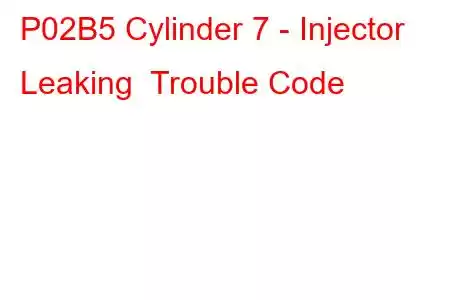P02B5 Cylinder 7 Injector Leaking
OBD-II Trouble Code Technical Description
Cylinder 7 Injector Leaking
What does that mean?
This is a generic powertrain diagnostic trouble code (DTC) and typically applies to OBD-II vehicles. That may include but is not limited to vehicles from , etc. Although generic, the exact repair steps may vary depending on year, make, model and powertrain configuration.
If your OBD-II equipped vehicle has stored a code P02B5, it means that the powertrain control module (PCM) has detected a possible leaking fuel injector for a particular cylinder of the engine, in this case it's cylinder #7.
Automotive fuel injectors require a precise degree of fuel pressure to deliver an exact measure of fuel in a precisely sprayed pattern to the combustion chamber of each cylinder. The demands of this precise pattern require that each fuel injector be free of leaks and restrictions.
The PCM monitors factors such as the degree of fuel trim required and exhaust oxygen sensor data, combined with crankshaft position and camshaft position, to detect a lean condition and pinpoint which cylinder of the engine is experiencing a malfunction.
Data signals from the oxygen sensors alert the PCM to lean exhaust oxygen content and also which bank of the engine is affected. Once it is determined that there is a lean exhaust condition on a specific bank of the engine, the position of the camshaft and crankshaft help to determine which injector is having a problem. Once the PCM has established that there is a lean condition and located the affected fuel injector on cylinder #7, a code P02B5 will be stored and a malfunction indicator lamp (MIL) may be illuminated.
Some vehicle applications may require multiple failure cycles in order for a MIL to be illuminated.
A cross section of a typical fuel injector:
What is the severity of this DTC?
A P02B5 should be classified as severe because a lean fuel condition could cause cylinder head or engine damage.
What are some of the symptoms of the code?
Symptoms of a P02B5 trouble code may include:
Diminished engine performance Reduced fuel efficiency Lean exhaust codes Misfire codes may also be storedWhat are some of the common causes of the code?
Causes for this P02B5 fuel injector code may include:
Defective and/or leaking fuel injector Open or shorted fuel injector circuit(s) Faulty oxygen sensor(s) PCM or programming error Mass air flow (MAF) or Manifold Air Pressure (MAP) sensor failureWhat are some P02B5 troubleshooting steps?
MAF and MAP related codes should be diagnosed and repaired before attempting to diagnose a code P02B5.
I like to begin my diagnosis with a general inspection of the fuel injection rail area. I would concentrate on the fuel injector in question (cylinder #7). Inspect the outside for signs of corrosion and/or leakage. If there is heavy corrosion on the exterior of the fuel injector in question, or if it is leaking, suspect that it has failed.
If no obvious mechanical issues are discovered in the engine bay, there are several tools that will be required for an accurate diagnosis:
A diagnostic scanner A digital volt/ohmmeter (DVOM) An automotive stethoscope A reliable vehicle information sourceNext, I would connect the scanner to the vehicle diagnostic port and retrieve all stored codes and freeze frame data. It will be helpful as my diagnosis unfolds. Now, I would clear the codes and test-drive the vehicle to see if the P02B5 is reset.
If the code P02B5 immediately returns, use the scanner to perform an injector balance test to verify that the misfire is an injector problem. Once you have done so, proceed to step 1.
Step 1
With the engine running, use the stethoscope to audibly monitor the fuel injector in question. An audible clicking sound should be hea
Read: 42


